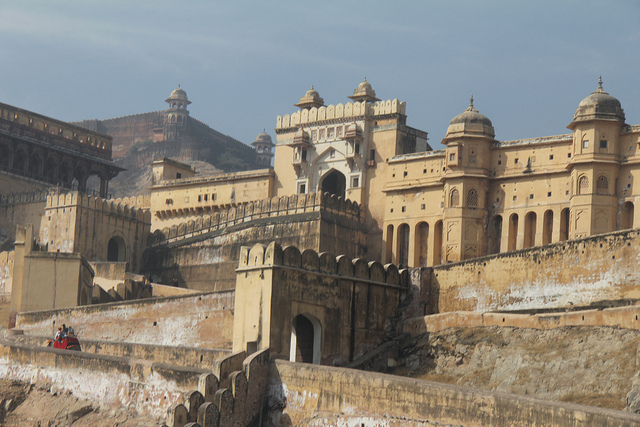Jaipur is the capital of the princely state of Rajasthan, the only ‘desert’ state in India, located in the north-west, along the border with Pakistan. Its history is unique in that the past is still trying to live in partnership with the present.
The title of Rajasthan was derived from the label of ‘Rajputana’ that the British officers had devised for this region during their rule (Raj) in India. The term Rajputana translates to mean the Land of the Rajputs.
This is a clan of the warrior classes in the Indian caste system. They are known for their chivalry and bravery. The term ‘Rajputana’ was not devised to apply to the common residents of these areas. It was purposely concocted to appease the rulers of this fiercely violent land.
The British were successful militarily in many other parts of India. When they approached the area of greatest density of princely states that is present-day Rajasthan, they were doubtful about their chances. Their policies of divide and rule did not work well here. And the rulers’ armies were very many and ready to fight to the death in many cases. This tradition of ‘Saka’ is one of the gems of Rajput culture, along with the tradition of ‘Johar’.
Finally the British offered peace to the princely states in exchange for an annual ‘Hazri’, the tribute extracted by them. Since the rulers of these states were very wealthy, they agreed to this agreement. The result is that British rule never directly existed in Rajputana. This provides a stark contrast in architecture, but primarily in culture between Rajasthan and the rest of India.
Ask any traveler who has spent extensive time in Rajasthan and they will tell you that the feudal feel in the background is even alive today. It may not necessarily favor the erstwhile rulers and nobles. But the power structures are still intact, regardless of who is currently in power. This offers a very interesting adventure for the intelligent visitor. Let us look at how you can best enjoy a 48 hour stay in Jaipur to get the most memorable experience.
Maharaja Jai Singh II planned and built Jaipur between 1727-1734. He used science and geometry in planning the city. We shall see an example of this right at the beginning of our 2 day tour.
DAY 1
Sunrise At ‘Galtaji’
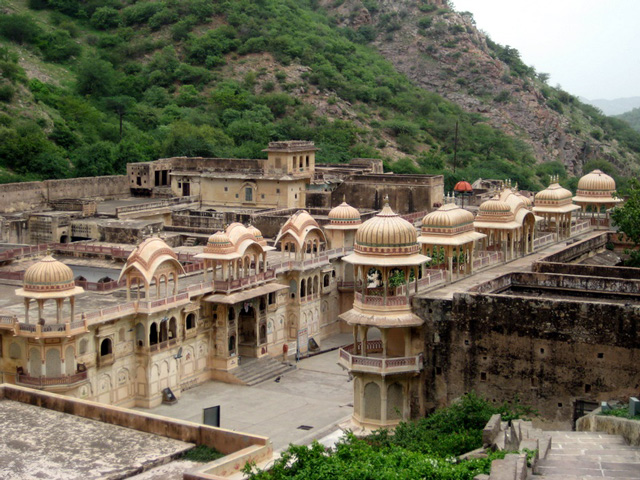
Photo by China Crisis, CC BY-SA 3.0
We will begin the first day at 6 AM. Jaipur had a protective built right around the entire city. There are seven massive gates in this wall at strategic points. One facing east at the point where the sun rises is appropriately called ‘Suraj Pol’. This translates to the ‘Sun Door’.
Right outside this gate are hills. There is a wide path leading up the hills. At the top, a little to the right, is the Sun Temple, where the rising Sun would be welcomed each and every day. This is the best point in the whole of Jaipur to watch the sunrise.
Descending down the other side of the hill, you will reach a natural spring in the pass, called ‘Galtaji’. The water from the sprout collects in a deep tank constructed by the Lords of Jaipur. It is customary to take a dip in these fresh natural waters. I would very strongly recommend it as an unforgettable experience. The custom is to strip down to the bare necessities, i.e. underwear or swimming gear before venturing in the water. Modest Indian women can be seen bathing in full clothing.
Morning At City Palace
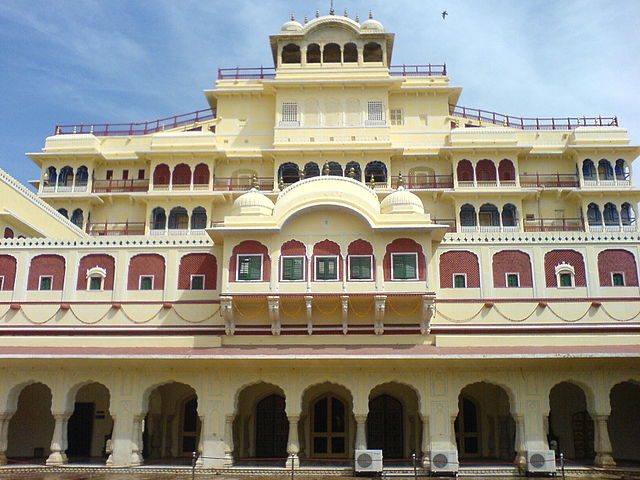
Photo by Rakesh, CC BY-SA 2.0
After our early morning bath, we will proceed to the center of town. Even today, this is where the erstwhile Royal Family lives, just like Queen Elizabeth of England. The City Palace is open for tourists to see for themselves the grandeur and vastness of its environs. The most famous, and unique to Jaipur, tourist attraction of Jaipur is the ‘Hawa Mahal’. This is a façade fronting the section of road right outside the old Town Hall. It has hundreds of small windows with extricate and exquisite stone lattice-work. During medieval India, women were to keep themselves veiled for their own safely. Intruders were known to kidnap girls and women. Wars were sometimes fought just to capture a ravishing beauty. Such were the times. The minute windows of Hawa Mahal allow the women to look out without being seen themselves.
Inside the City Palace is located Maharaja Jai Singh II’s famous ‘Jantar Mantar’. This was his Royal Observatory. The huge sundials that you can see here could measure time to the exactness of a second. This so impressed the Mughals of Delhi that they requested he construct a similar observatory in Delhi for them.
Afternoon At The Museum
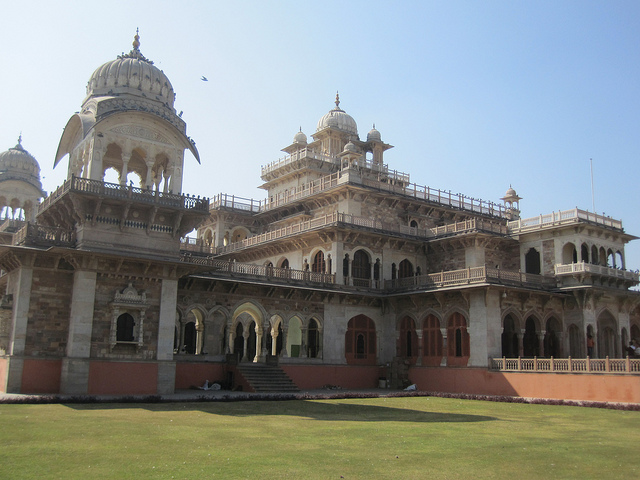
Photo by Rolling Okie, CC BY 2.0
With its vivid and eventful past, Jaipur has much history to offer the traveler. The ideal place to learn about Jaipur is at the City Museum, artistically set within the Ram Niwas Gardens. Here you will find many of the items which featured in Jaipur’s history. Including one of the pair of massive silver pots that Maharaja Madho Singh II had fashioned when he went to London to meet Queen Victoria. Being a devout Hindu, he was afraid of having to drink water from unknown sources during his trip. It was common for Kings to be poisoned in those days. He commissioned a pair of massive silver pots. He ordered that water from the Holy Ganges River should be filled in these pots before they were loaded onto his steamer for London. During his entire trip, he only drank this water.
Sunset At Nahargarh
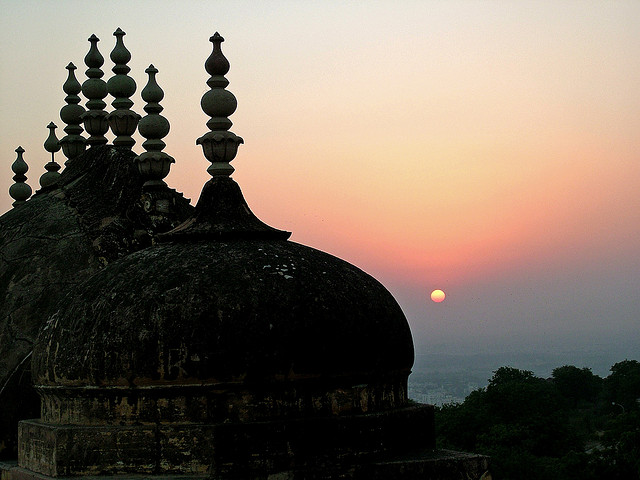
Sunset at Nahargarh Fort – Photo by Guilhem Vellut, CC BY 2.0
From the City Palace you can see a mountain with a fort atop it. This is Jaipur’s famous Nahargarh Fort. And we are going to climb up to it. The road leading up to the fort runs through the old city and winds its way up the hill. It is wide enough for elephants to be brought up. It was customary for royals to always be seated on elephant-back when out in public in peacetime. As you keep rising, you get to see more and more of the expanse of the city. And this is hardly all of it.
There is a nice restaurant where you can get some much-needed refreshment after the climb up. Before sunset we want to proceed to the Durg Café, located right at the end of Nahargarh Fort. The name of the fort translate as the Lion Fort. It is not just to showcase its strength. There were actually lions roaming here in the wild when the fort was built. There is still a thick jungle behind the fort today where you can very likely meet some dangerous animals.
Watching the sunset from Durg Café is a really magical moment. You will first see the sun go down. Then you will see the lights of the city some on, one by one, under you. As the sky darkens, you will finally see the stars come out to compete with the flashes of lights from the city below.
DAY 2
Morning At Amer
Photo by Piyush Kumar, CC BY 2.0
The founder of Jaipur, Maharaja Jai Singh II was the King of Amer when he planned and built Jaipur. His ancestors had already been ruling Amer for centuries before he conceived of a bigger city. Even today the Amer Fort, the erstwhile residence of Jaipur’s royal family is a sight to behold.
You have the chance to know what the royals felt like atop the elephant by climbing on one yourself at Amer. The ascent up to the fort by elephant is a popular favorite with visitors to Jaipur.
Inside the fort, you can see the expansive courtyards and gardens that were used by the royal courts earlier. Amer was not originally made by the ruling family of Jaipur. It was the citadel of the Meena tribe. When they were conquered by the ancestors of the current ruling family, they requested to be at the victor’s service. Since then generation after generation of this tribe has been in the service of the royals.
There is an interesting episode concerning the loyalty of these generations-old retainers. The Rajput rulers of Amer constructed another fort way above Amer Fort, called Jaigarh Fort. This was actually built to fashion ‘Jaiban’, the world’s largest cannon. The name translates to the weapon of victory. Rumour has it that when it was tested, the cannonball fired fell at a village some 40 kilometers away. A deadly weapon indeed. The foundries which created this massive cannon are also worth a visit.
Jaigarh was also where the Royal Treasury was located. Even after Independence from the British and the creation of the Union of India, the treasury was still located here. It is said that the treasuries were so rich that even the royals, including the King and Queen, were not permitted to view all of them. When they needed a item, they would be taken blindfold into the treasury, asked to select the item they wished for, and then be blindfolded again to be led out.
When, after Independence, the Government of India sent officers from the Income Tax department to Jaigarh to assess the wealth, the Meena guards would not let them pass. They only recognized the suzerainty of the royal family of Jaipur. The Head Guard, who was still armed with a sword at this time, apparently offered his sword to the income tax officers, asking them to cut off his head. For he said, while he was living, he would let nobody but the royal family pass within.
Such loyalty is what makes Rajasthan stand out in India.
Lunch At Jal Mahal
Photo by Dimitry B., CC BY 2.0
On the way back from Amer and Jaigarh to Jaipur, you will see an expansive lake to your left with a Palace ‘floating’ in the middle. This is the luxurious Jal Mahal Palace. The name translates as the Water Palace. To think that just one family would have so many monuments and structures built for them gives you an idea of their power. These were Kings and these were their kingdoms.
Jal Mahal lays out a fine spread for lunch. You can sit back and feast while watching the placid waters of the lake rippling below you.
Dinner at Choki Dhani
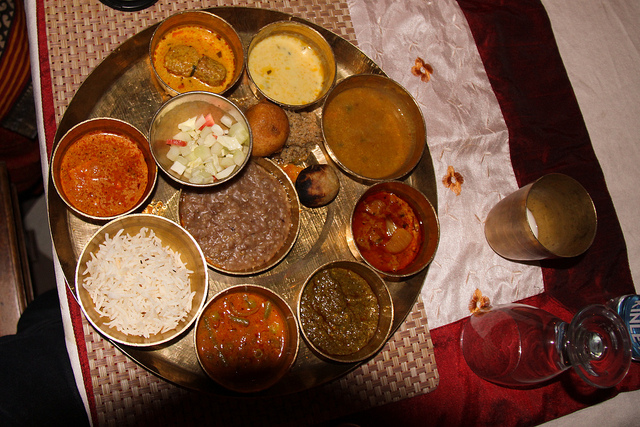
Photo by Piyush Kumar, CC BY 2.0
So far we have seen all the vestiges of Rajasthan’s royal past. To end, we shall feel some of its traditional rural life too. There is an amazing resort called Choki Dhani. Here they have re-created the typical rural Rajasthani environment. A big hit with the nearby young urban crowd from New Delhi, you really feel part of a festival or fair here. There are 4 types of animal rides to choose from. You can ride a bullock-cart, a horse-driven carriage, a camel or an elephant. There are local magicians performing their ancient arts. You get a wide variety of local craftsmen selling typical Rajasthani jewelry and other trinkets. You have the shows of typical Rajasthani dancing forms such as ‘Kala-beliya’ being performed. Once you have partaken of enough physical excitement and built up a healthy appetite, it is time for the typical Rajasthani dinner. You will be seated cross-legged on a mat on a wooden floor. You will be served each and every dish, including the plates, bowls, glasses and other utensils. In Rajasthan, once you have sat down to eat, you are not expected to need to get up until you have finished eating. As a guest of Rajasthan, they ensure here that you are fed till the gills before they allow you to get up. In all, you will feel pretty much a typical Rajasthani yourself by the time you’re done here.
At the end of our two days, it is time to say goodnight. I’m sure the activities of the day would have made you very much desire a warm bed at night. Have a sound sleep and think of Jaipur in your dreams.
